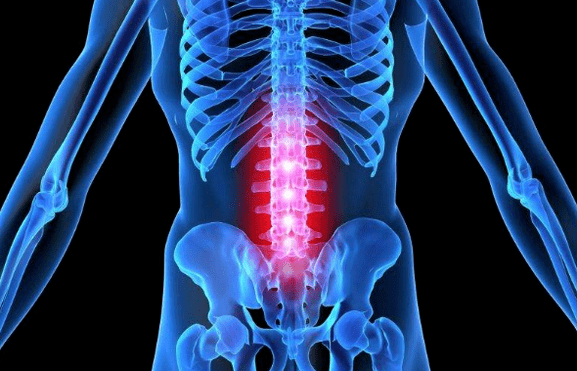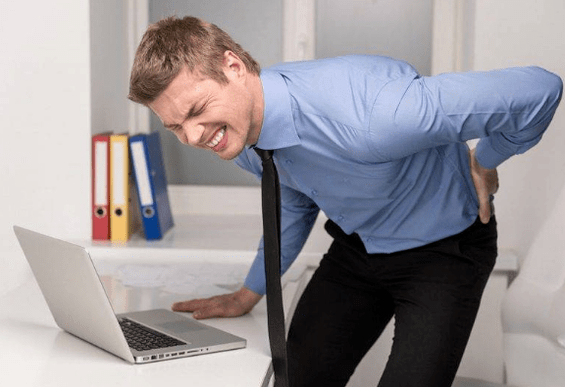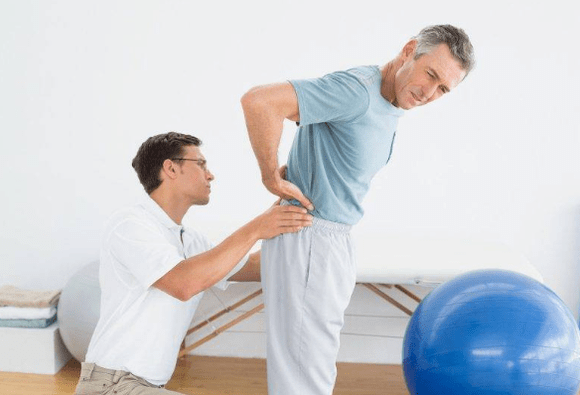The pain in the lower back affects people more often after 35 years.In the vast majority of cases, the disease is associated with the deformation of the vertebrae and its consequences.The timely appeal to the doctor will accelerate the recovery, since the symptoms and treatment of the osteochondosis of the lumbar column are interconnected concepts.

The greater the progress of the disease, the more serious consequences are, the more difficult the process of restoration of health is difficult.
Signs and symptoms of osteochondosis of the lumbar column
The lumbar region is located between the sacred and the thoracic department and consists of five vertebrae connected by intervertebral discs.
The development of osteocondrosis means the wear of the intervertebral discs that play a role of shock in the loads on the spine.The base of the discs is a mass similar to the gel, protected by a dense fibrous ring and cartilage, and the internal space is filled with a liquid octopous nucleus.
As the loads on the vertebrae, the elasticity and flexibility of the intervertebral discs are lost, such as their height, and the microocracks are formed in the fibrous ring, which over time lead to its breaking and damage to the Pulpic nucleus.
The destruction of the tissues is accompanied by a pinch of nerve roots located on both sides of the vertebrae and causes severe pain.
The main signs of the lumbar osteocondrosis:
- backache;
- fatigue and depression;
- Weakness or excessive muscle tension;
- Loss of sensitivity in the limbs, buttocks or hips;
- Acute or painful pains and spasms in the lower back, often giving the legs;
- Violation of the motor function.
Against the background of serious vertebral injuries, other symptoms are also observed in the lumbar region, very often, dysfunction of other organs: the urinary and sexual system, the gastrointestinal tract.
Causes
Like most diseases of the musculoskeletal system, osteochondrosis can develop for many reasons.Some of them are in the lifestyle and in the diet, the other part develops against the background of the physiological characteristics of the body.
Quite often, the treatment of osteochondosis of the lumbosacral column is required by athletes whose back is subject not only by constant loads of power, but also by periodic injuries.
The second category of people who are at risk, people who, by virtue of their profession, spend a lot of time in one position: teachers, hairdressers, chefs, chargers, waiters, programmers, employees and drivers.
Among the other causes of the development of the pathology:
- Excess weight;
- violation of the metabolism;
- improper posture, china;
- genetic predisposition;
- injuries;
- bad habits;
- a lack of beneficial trace elements and vitamins in the diet;
- Abnormal development of the muscle system, flat feet;
- hypothermia;
- sedimentary, static;
- Frequent stress.
All the factors listed can affect the elasticity of the intervertebral discs, since they contribute to a violation of the blood circulation or to the appearance of a lack of nutrients that enter the vertebrates.
Degree of osteochondrosis of the lumbar column
Depending on the level of damage to the spine, the four degrees of development of osteochondrial processes are distinguished, manifested in phases while the disease develops.
The first degree.
The pathological processes in the spine start long before their first clinical manifestation.Consequently, the losses of humidity, the intervertebral discs become less elastic elastic.The height of the discs is stored normal.The patient feels discomfort in the lower back.
The second degree.
Against the background of the lack of humidity, the microocacks appear in the fibrous ring and the inflammation of the tissues develops.The hooks of the vertebrae of the vertebrae gradually increase.In the cartilage there are seals.The patient complains of back pain, giving to the feet or groin.Motor skills can be limited.In the work of the internal organs, faults occur.
The third degree.
The integrity of the fibrous ring is disturbed, the intervertebral disc that comes out, forming an hernia.Ships and nerve endings are tablets.Muscle spasms, dysfunctions of the pelvic organs, a sensitivity disorder of the lower limbs, prolonged attacks of radicalitis are observed.
The fourth degree.
The most complex, not susceptible to treatment, stadium during the disease.As a result of the complete destruction of the intervertebral records, scars are formed in their place.The vertebrae are at most and gradually deform.With the development of the compression of the spinal cord, paralysis of the lower limbs is possible.
Diagnostics
To recognize the disease and determine the exact diagnosis, neurologists use a complex of measures: a history of anamnesis, physiological examination and hardware studies.

Hang -up collection.
Provides for the study of the patient complaints:
- the cause of anxiety;
- place of location of the discomfort;
- duration and intensity of unpleasant sensations;
- the duration of the disease;
- possible causes of the disease;
- frequency of exacerbations;
- factors that cause exacerbations;
- Factors that improve well -being.
In addition, the doctor studies information on the patient's lifestyle, diet, labor and rest, the presence of bad habits, hereditary factors and injuries.
Physiological examination.
It is performed to determine pathological changes and make a preliminary diagnosis.
During the exam, the doctor evaluates the patient's motor skills: pace, posture, breadth and volume of movements.The palpation method examines the condition of the muscles: tone, size, volume of spasms.Using a small tingling, it sets the level of sensitivity.Taping with a hammer allows you to discover the pain irradiation area.
Hardware search
To obtain complete and accurate information on the position of the pathology and the degree of tissue injuries, doctors use research through various types of medical equipment.
X -ray.The study of the lumbar region through a radius X allows us to establish anatomical parameters of the vertebrae and intervertebral discs, the tendency to restrict the holes between the bases, the presence of bone growth.
Tomography.The use of electromagnetic waves provides the output of the image of the area designed on the screen for further studies and analysis of the state of the blood vessels that feed the fabric of the spine, the nerve processes and the intervertebral discs.
Ct.The images of different spinal segments are performed using a X -ray radiation. The image is displayed on the monitor to determine the nature of the changes in ships, the membrane of the vertebrae and the spinal cord and the regional growths.
For differential diagnostics, various types of studies are used to eliminate pathologies of other body systems.
Treatment of the osteochondrosis of the Lumbosacral column
The duration and characteristics of the treatment of lumbosacral osteochondrosis depend on the results of the diagnostic measures.In the early stages of the development of the disease, conservative treatment is indicated.With more complex lesions of the spine, surgery is used.
The optimal therapeutic effect is obtained through complex therapy, which provides for the use of local drugs, physiotherapy, massage and healing gymnastics.
Pharmacological treatment
To relieve the symptoms, non -pound drugs are prescribed for internal and external use: tablets, injections, ointments.In addition, chondroprotectors, neuroprotectors, diuretics, vitamins, relaxants are used.
Pharmacological treatment allows:
- eliminate pain;
- remove inflammation;
- relax the muscles;
- Restore the destroyed cartilage tissue;
- improve blood circulation;
- reduce swelling;
- increase physical activity;
- Normalizes brain nutrition.
In acute pains, Novocaine blocks are used which provide an instant effect.
Popular remedies
Treatment with folk methods is effective as an additional drug for drug therapy.The main techniques of traditional medicine are based on the use of vegetable materials, animal products and chemicals.
On the basis of various components, ointments and compressed, decoctions and infusions for internal and external use are prepared, as well as for therapeutic baths.
Physiotherapy for lumbar osteochondrosis
Physiotherapeutic procedures are a great way to restore the motor functions of the spine after damage to the osteocondrosis.
The main physiotherapy methods include:
- Electrotherapy - exposure to weak electric currents to improve blood circulation in tissues;
- Magnetotherapy - the use of magnetic fields to restore fabrics on a cellular level;
- Laser therapy - Complete activation of biological processes in vertebrates and nerve terms;
- Therapy of shock waves, an improvement in microcirculation and metabolic processes in the tissues affected by the effect of an acoustic wave;
- Balnetherapy - the use of the healing properties of mineral water.

The physiotherapy procedures not only several times increase the effectiveness of the pharmacological treatment, but also contribute to the healing and strengthening of the body as a whole.
Massage for osteochondosis of the lumbar
Visiting the massage procedures is one of the most pleasant and effective methods for the treatment of osteochondosis.
Using therapeutic massage:
- eliminate muscle cramps;
- improve the flow of blood to the affected areas;
- improve the outflow of the lymph;
- restore the muscles that have exposed atrophy;
- Remove the restriction of mobility.
The massage is prescribed when the pain syndromes are eliminated.
Therapeutic gymnastics
The main task of operating therapy for osteochondrosis is to restore the functionality of the spine and its correction.However, you can only attend lessons after eliminating the symptoms of exacerbation.
The most effective methods of therapeutic exercises are considered:
- charger;
- visit the gym;
- Water therapy, swimming.
At home, you can use a circle for sport.Some doctors to restore the flexibility of the spine recommend yoga lessons to their patients.
Excessive osteochondrosis exercises
Any exercises for osteochondrosis must be performed slowly and without sudden movements.
To strengthen the muscles that support the vertebrae, approaching the exercises performed on the stomach.In this case, the hands are stretched with a slight sip, but without tension.Repeat 4 times.
Surgery
They remind the treatment of the spine in particularly difficult cases - with significant neurological disorders, as well as in the event of loss of control over intestinal movements.
During the surgical intervention, the removal of the source of the disease is guaranteed and measures are performed to stabilize the spine.The postoperative period lasts several months.
Why is lumbar osteochondosis dangerous?
The degenerative changes that occur with lumbar osteochondrosis contribute to the development of many diseases dangerous for human life.Against the background of intervertebral, protruding, lumbago and Isechias.
Further progress of the disease can cause the fall from the intervertebral disc and the formation of Spinoz.In addition to the strong pain that accompanies pathologies, the motor skills of a person are violated, until the complete loss of them.The paralysis of the lower limbs develops.
With significant damage to the membrane of the spinal cord, death is inevitable.
Prevention
To avoid destructive changes in the spine, you must take care of a healthy lifestyle:
- doing sports - swimming, hardening;
- adhere to correct balanced and good nutrition;
- exclude bad habits;
- maintain posture;
- Support the spine during sleep using an orthopedic mattress.
In addition, it is advisable to avoid hypothermia, weight lifting.Women are not recommended to often wear high -wheeled shoes.
You can maintain lumbar health if regulates your lifestyle and do not forget the importance of physical activity.



















